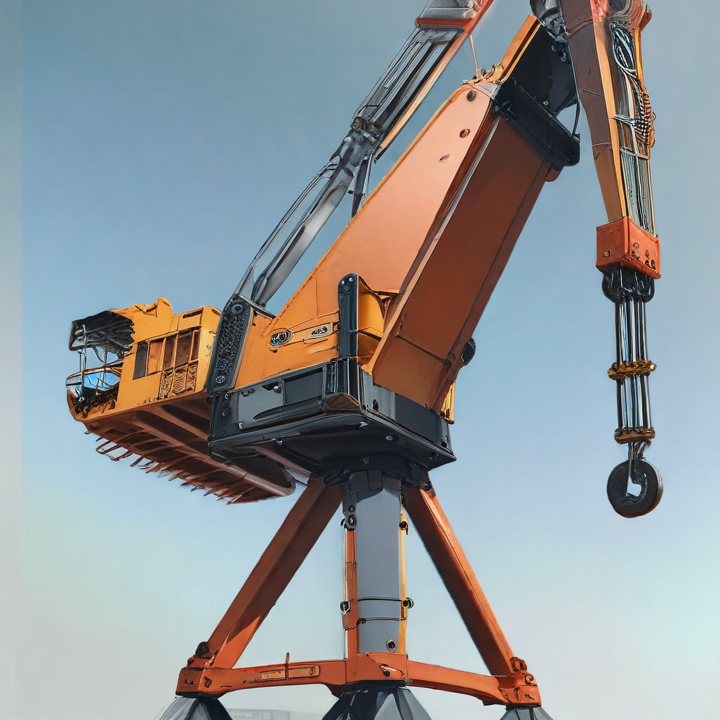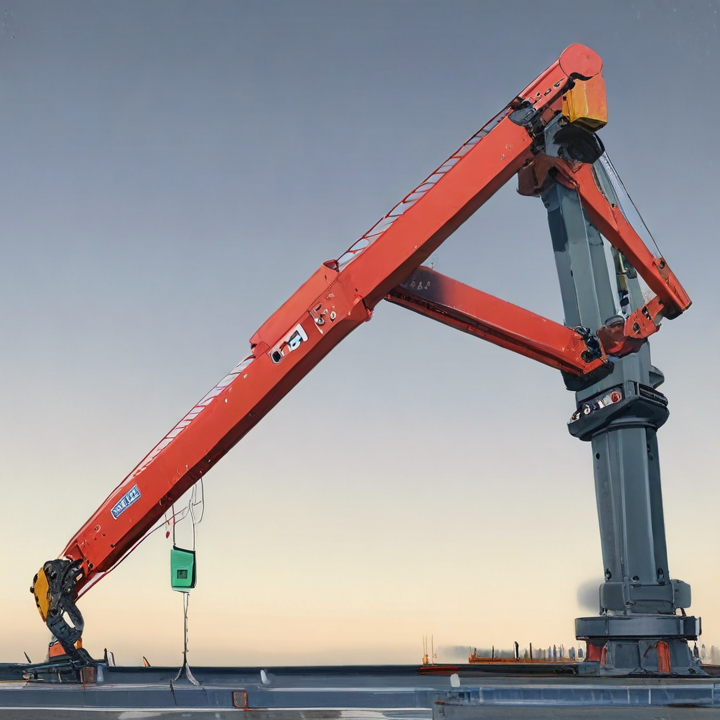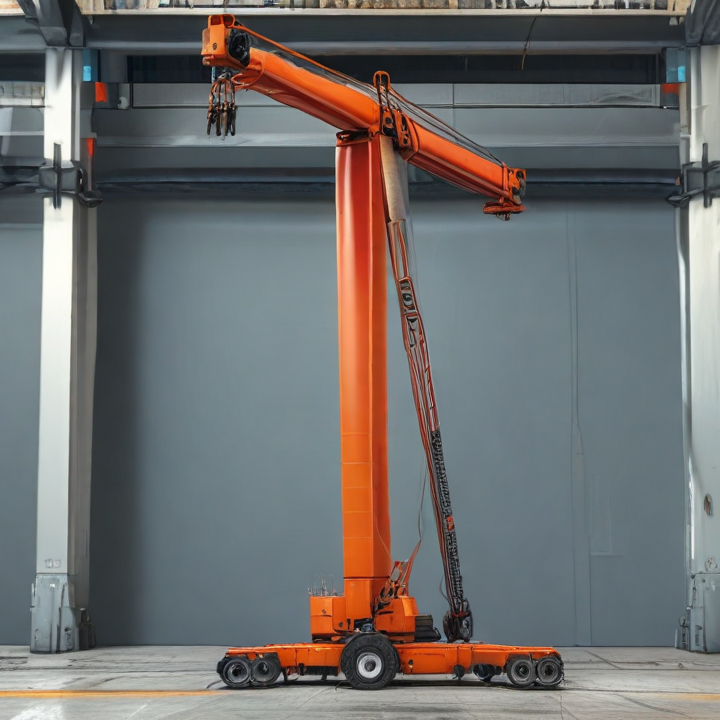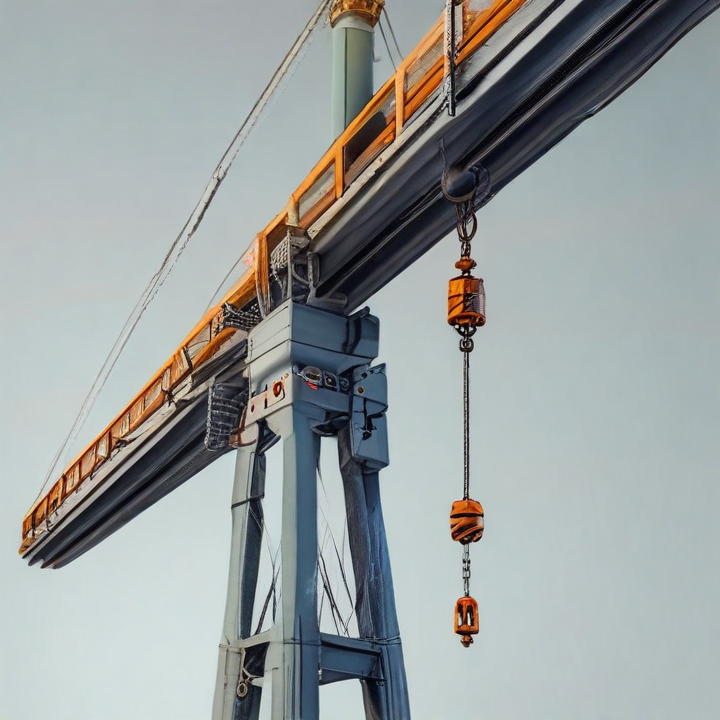articulating jib crane Safety Certifications
Articulating jib cranes are essential equipment in various industries, offering flexibility and ease of use for material handling tasks. Ensuring their safe operation and compliance with safety standards is crucial to prevent accidents and maintain workplace safety. Here’s a brief overview of safety certifications for articulating jib cranes:
1. OSHA Compliance: The Occupational Safety and Health Administration (OSHA) sets regulations for the safe operation of cranes in the workplace. Articulating jib cranes must comply with OSHA standards, specifically OSHA 1910.179, which outlines requirements for overhead and gantry cranes.
2. ANSI Standards: The American National Standards Institute (ANSI) provides guidelines to ensure the safety and reliability of cranes. For articulating jib cranes, ANSI/ASME B30.11 applies, covering safety standards for underhung cranes and workstation cranes, which include jib cranes.
3. CMAA Certification: The Crane Manufacturers Association of America (CMAA) offers certifications and guidelines that ensure cranes meet rigorous performance and safety standards. CMAA’s Specification No. 74 provides a detailed framework for the design and manufacturing of overhead cranes, including jib variations.
4. ISO Standards: The International Organization for Standardization (ISO) offers global standards ensuring the safety and efficiency of lifting equipment. ISO 9927 and ISO 4301 set forth requirements for the inspection, maintenance, and operation of cranes, contributing to international safety and quality assurance.
5. CE Marking: In Europe, articulating jib cranes must have CE marking, indicating compliance with EU safety, health, and environmental protection requirements. The Machinery Directive 2006/42/EC is particularly relevant, governing the design and manufacturing of machinery, including cranes.
6. Load Testing and Certification: Regular load testing procedures must be conducted to verify the crane’s performance under maximum load conditions. Certification from accredited bodies or engineers ensures that the crane meets specified load-bearing capacities and safety requirements.
Adhering to these certifications and standards not only ensures the safety of operators and workers but also enhances the reliability and longevity of the equipment. Regular inspections, maintenance, and staying updated with current safety standards are imperative for optimal operation.
List Reference Technical Parameters of “articulating jib crane”
Sure, here are the key technical parameters for an articulating jib crane:
1. Capacity:
– Maximum Load Capacity: Indicates the maximum weight the crane can lift. Usually specified in tons or kilograms.
2. Span/Reach:
– Maximum Span: The maximum horizontal distance the jib arm can extend from its pivot point.
– Articulating Arm Lengths: Typically composed of two arm segments, each with its specific length, ensuring a wider range of motion.
3. Height:
– Under Boom Height: Distance from the floor to the underside of the jib arm.
– Overall Height: Total vertical height of the crane including the mounting structure.
4. Rotation:
– Primary Arm Rotation: Angular displacement range of the primary arm; often up to 360 degrees.
– Secondary Arm Rotation: Often up to 360 degrees for the additional articulating arm.
5. Mounting Options:
– Floor Mounted: Secured using a base plate anchored to the floor.
– Wall/Column Mounted: Attached to existing structural supports.
– Pedestal Mounted: Often used for outdoor or remote locations.
6. Power Source:
– Manual: Hand-operated mechanisms like push-pull systems.
– Electric: Powered via electricity for enhanced ease of operation.
7. Speed:
– Rotation Speed: Speed at which the jib arm can pivot or rotate.
– Lifting Speed: Speed at which the hoist can raise or lower a load.
8. Control System:
– Pendant Control: Handheld device for manual operations.
– Remote Control: Wireless operations providing more flexibility.
– Automated Control: Featuring programmable logic controllers (PLCs) for precision tasks.
9. Material:
– Construction Material: Typically steel for durability and strength; options for corrosion-resistant materials for specific applications.
10. Safety Features:
– Overload Protection: Prevents lifting beyond the crane’s rated capacity.
– Emergency Stop: Quick halt button in case of an emergency.
– Limit Switches: Mechanisms to prevent over-travel of the hoist or jib arm.
Articulating jib cranes offer significant flexibility and precision suited for diverse industrial applications, emphasizing ease of operation and safety.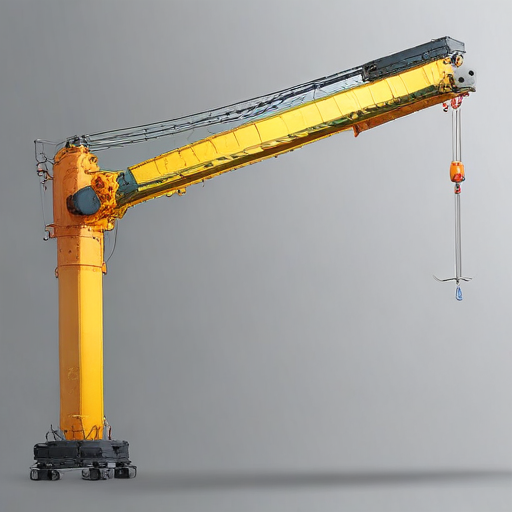
List Product features of “articulating jib crane”
An articulating jib crane is a versatile material handling device designed to lift, move, and position loads with precision and ease. Here are its key product features:
1. Articulating Arm: The dual-arm design provides enhanced flexibility and a wide range of motion, ensuring that loads can be positioned precisely and easily.
2. 360-Degree Rotation: Both primary and secondary arms can rotate independently, offering full-circle coverage. This allows for optimal maneuverability around obstructions.
3. Load Capacity: Typically ranges from a few hundred pounds to several tons, catering to various industrial and commercial lifting needs.
4. Reach and Coverage: Available in multiple arm lengths and heights to provide extensive coverage within a workspace, enhancing operational efficiency.
5. Ease of Installation: Can be mounted on floors, walls, ceilings, or via freestanding structures, allowing integration into diverse work environments with minimal disruption.
6. Durability: Made from robust materials such as high-grade steel, ensuring long-term durability and resistance to wear and tear under heavy usage.
7. Smooth Operation: Equipped with ergonomic handles and precision bearings to facilitate smooth and controlled movements, reducing operator fatigue.
8. Safety Features: Incorporates locking mechanisms, overload protection, and other safety features to ensure secure handling of loads and protection for operators.
9. Customized Configurations: Options for customized heights, arm lengths, and load capacities to meet specific application requirements.
10. Versatile Applications: Ideal for manufacturing, assembly lines, warehouses, automotive industries, and other sectors requiring efficient material handling solutions.
11. Minimal Footprint: Space-efficient design ensures that the crane occupies minimal floor space while offering maximum operational range.
12. Low Maintenance: Designed for easy maintenance with readily accessible components, ensuring minimal downtime.
Combining flexibility, strength, and precision, articulating jib cranes significantly enhance productivity and safety in environments requiring frequent lifting and positioning of materials.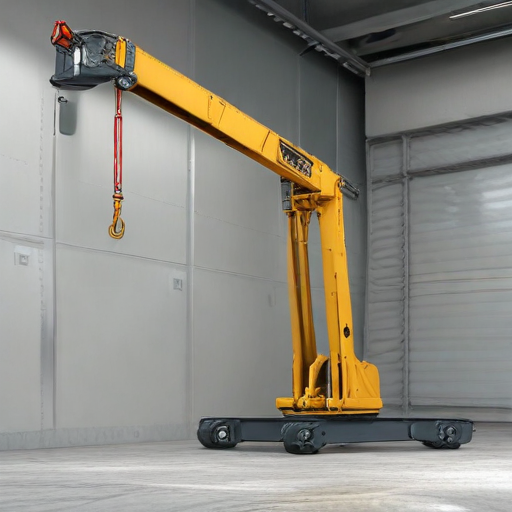
List Various Types of “articulating jib crane”
An articulating jib crane is a versatile lifting device that features a unique arm or boom with two pivoting points, allowing for enhanced maneuverability compared to traditional jib cranes. Here’s an overview of various types of articulating jib cranes:
1. Wall-Mounted Articulating Jib Crane:
– Attached to a wall or column, these cranes save floor space and provide wide coverage. Suitable for workstations with space constraints.
2. Floor-Mounted Articulating Jib Crane:
– Installed directly onto the floor, these cranes offer robust and stable lifting capabilities. Ideal for areas requiring heavy-duty operations.
3. Ceiling-Mounted Articulating Jib Crane:
– Suspended from the ceiling, this type maximizes floor space while offering flexible material handling. It is commonly used in clean rooms or production areas with limited floor space.
4. Mast-Style Articulating Jib Crane:
– Features a mast mounted to the floor or an existing structure, providing 360-degree rotation and extensive coverage. Useful for large, open spaces.
5. Portable Articulating Jib Crane:
– Mobile and flexible, these cranes can be moved to different locations as needed. They are ideal for temporary workstations or areas with changing layouts.
6. Workstation Articulating Jib Crane:
– Designed for lifting lightweight loads efficiently within a confined space, often integrated into production lines or assembly stations.
By integrating dual pivot points, articulating jib cranes offer unmatched flexibility and accessibility, making them suitable for complex lifting tasks in various industrial settings. Each type caters to specific spatial and operational requirements, offering tailored solutions for enhanced productivity and safety.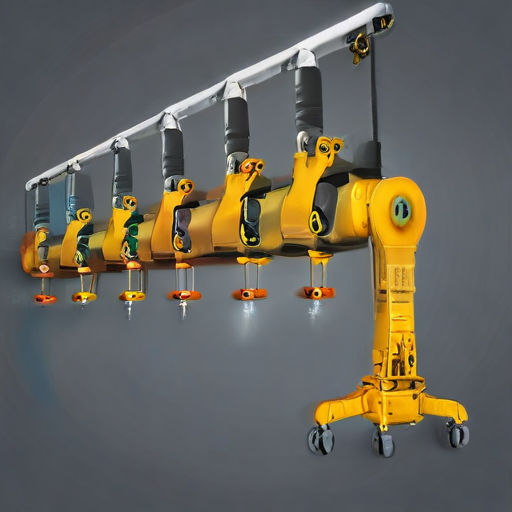
List Application of “articulating jib crane”
Articulating jib cranes are versatile material handling systems that can be found in various industrial and commercial settings. Their primary function is to assist in the lifting, positioning, and moving of heavy materials with precision. Here are some key applications:
1. Manufacturing Floors:
– Assembly Lines: Efficiently moving components between workstations.
– Machinery Loading: Positioning heavy machinery parts with precision.
2. Warehousing and Distribution:
– Loading and Unloading: Assisting in the efficient loading of trucks.
– Material Storage: Placing items on high storage racks with ease.
3. Automotive Industry:
– Engine Assembly: Precisely positioning engine blocks.
– Parts Handling: Supporting the lift and transport of various auto parts.
4. Aerospace:
– Component Assembly: Handling delicate and heavy parts during aircraft assembly.
– Maintenance: Facilitating the maintenance of aircraft components.
5. Marine:
– Shipbuilding: Moving large ship components.
– Dock Operations: Assisting in loading and unloading cargo.
6. Construction Sites:
– Material Positioning: Assisting in placing construction materials at desired locations.
– Tool Handling: Supporting heavy tools and machinery.
7. Pharmaceuticals and Chemical Plants:
– Safe Handling: Assisting in the handling of hazardous materials to ensure safety.
– Precision Placement: Supporting the precise positioning of sensitive equipment.
8. Food and Beverage:
– Processing Lines: Lifting and placing heavy ingredients or machinery.
– Packaging: Assisting in the movement of large packaging materials.
9. Energy Sector:
– Power Plants: Moving and positioning heavy machinery such as turbines.
– Renewables: Assisting in the installation and maintenance of wind turbines and solar panels.
These applications demonstrate the versatility and essential role of articulating jib cranes in enhancing productivity, ensuring safety, and facilitating precision in various industries.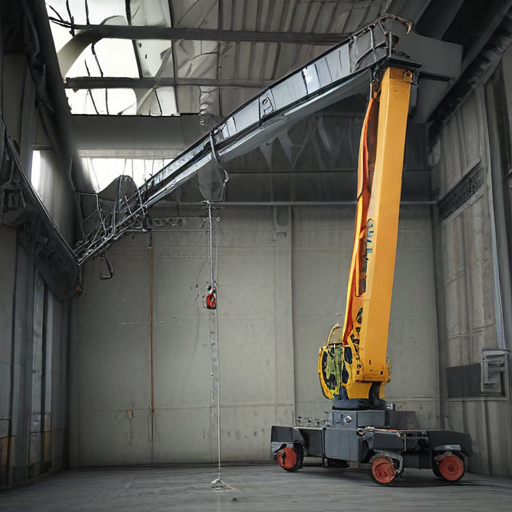
List Buyer Types of “articulating jib crane”
Buyer types for articulating jib cranes vary widely across industries due to their versatility and utility in material handling. Here are some prominent buyer types:
1. Manufacturing Facilities:
– These facilities often require efficient material handling solutions for assembly lines and production processes. Articulating jib cranes help in moving heavy parts, tools, and machinery with precision.
2. Warehouses and Distribution Centers:
– In warehouses, articulating jib cranes are used for loading and unloading goods, as well as for placing items on high shelves. The flexibility of these cranes aids in optimizing storage space and workflow efficiency.
3. Automotive Industry:
– Automotive plants use articulating jib cranes for lifting and positioning engines, transmissions, and other heavy components during assembly and maintenance.
4. Aerospace Industry:
– Aerospace manufacturers employ these cranes for precise handling of aircraft components, which are often large and delicate, requiring careful maneuvering.
5. Shipbuilding and Marine Industry:
– For constructing and maintaining ships, articulating jib cranes assist in lifting large metal sheets, engines, and other essential parts.
6. Chemical and Pharmaceutical Plants:
– In these plants, jib cranes are used to handle drums, vats, and other heavy containers, ensuring safe and efficient material movement.
7. Construction Sites:
– Articulating jib cranes are valuable on construction sites for lifting and placing building materials such as beams, bricks, and concrete forms.
8. Maintenance Departments:
– Various industries’ maintenance departments use these cranes for routine repairs and equipment servicing, ensuring safety and efficiency.
9. Utility Companies:
– Companies involved in utilities like water, gas, and electrical services use articulating jib cranes for infrastructure maintenance and equipment handling.
10. Educational and Research Institutions:
– Laboratories and technical institutions may use these cranes for research purposes, including the handling of experimental apparatus and materials.
The common need across these buyer types is the ability to lift, move, and position materials safely and efficiently, making articulating jib cranes a valuable asset in their operations.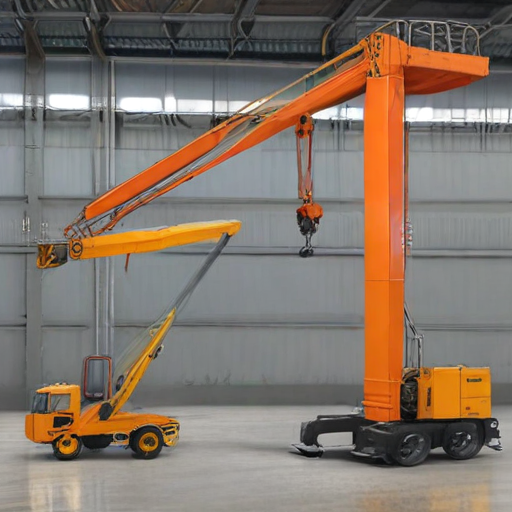
List “articulating jib crane” Project Types for Different Industries
Certainly! Articulating jib cranes are versatile pieces of lifting equipment used across various industries for different project types. Here’s a concise rundown:
1. Manufacturing Plants:
– Assembly Line Support: Facilitates the easy movement of parts between workstations.
– Material Handling: Lifts and moves heavy equipment and raw materials efficiently.
2. Warehouse and Logistics:
– Loading and Unloading: Assists in loading and unloading cargo from trucks or storage areas.
– Inventory Management: Helps manage and organize inventory, reducing handling time.
3. Construction Sites:
– Modular Construction: Efficiently handles panels, modules, and other building components.
– Tool and Material Hoisting: Moves tools and materials to various levels of the construction site.
4. Automotive Industry:
– Engine Assembly: Supports the assembly and disassembly of engines and other heavy components.
– Parts Handling: Manages the lifting and positioning of large automotive parts.
5. Marine and Shipyards:
– Boat Maintenance: Aids in the maintenance of ships by hoisting heavy equipment and parts.
– Dock Operations: Facilitates loading and unloading of cargo on ship decks.
6. Aerospace Industry:
– Aircraft Assembly: Handles large, sensitive aircraft parts during the assembly process.
– Maintenance and Repair: Assists in the maintenance, repair, and overhaul (MRO) of aircraft.
7. Chemical and Pharmaceutical Plants:
– Process Support: Handles containers and equipment required for chemical processing.
– Laboratory Use: Moves delicate instrumentation and materials within laboratories.
8. Food and Beverage Industry:
– Production Line Support: Transports raw materials and finished products along production lines.
– Packaging: Assists in the packaging processes, especially with heavy or bulk items.
9. Mining Operations:
– Equipment Handling: Moves heavy mining equipment and tools.
– Material Transport: Facilitates the handling of mined materials.
10. Utilities and Power Plants:
– Maintenance: Supports the maintenance of turbines, transformers, and other heavy components.
– Infrastructure Building: Assists in the construction and refurbishment of power plant infrastructures.
Articulating jib cranes enhance operational efficiency by providing flexible and precise lifting capabilities across these diverse industrial projects.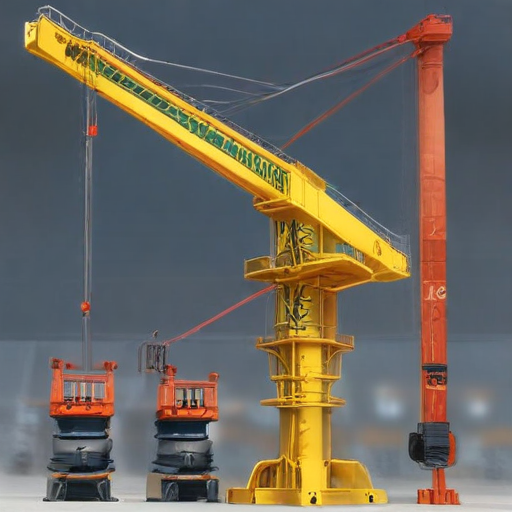
articulating jib crane Accessories Upgrades and Custom Manufacturing Options
An articulating jib crane is an essential investment for many industries due to its flexibility and efficiency in handling materials. Adding accessories, upgrading components, and opting for custom manufacturing can further enhance its performance to meet specific operational needs. Here are some key options:
Accessories:
1. Hoists: Select from electric, pneumatic, or manual hoists depending on load requirements and operational speed.
2. End Effectors: Custom grippers, magnets, or vacuum lifters can be used to handle specific materials safely.
3. Slip Rings: These provide continuous electrical power or signal to rotating parts, ideal for 360-degree operations.
4. Control Systems: Wireless controls, push-button pendants, and variable frequency drives can streamline operations and enhance safety.
5. Trolleys: Choose from manual, push, or motorized trolleys for smooth movement along the jib arm.
Upgrades:
1. Capacity Enhancement: Reinforce structures or upgrade components to handle heavier loads.
2. Rotation Mechanisms: Implement motorized rotation for the jib arm, improving maneuverability and reducing manual effort.
3. Track Extensions: Longer or additional tracks can be installed to cover a larger working area.
4. Safety Systems: Integrate overload sensors, emergency stop systems, and anti-collision devices.
5. Corrosion Resistance: Use specialized coatings or stainless steel components for environments with high moisture or chemicals.
Custom Manufacturing Options:
1. Tailored Dimensions: Customize the height, reach, and arm length to fit specific operational spaces.
2. Special Materials: Use high-strength alloys or weather-resistant materials to suit specific environmental conditions.
3. Integration with Existing Systems: Design the crane to seamlessly integrate with other machinery or assembly lines.
4. Ergonomic Designs: Implement ergonomic features to reduce operator fatigue and increase productivity.
5. Load Monitoring Systems: Integrate smart load cells and monitoring systems for real-time tracking and data analysis.
By carefully selecting and integrating these accessories, upgrades, and custom options, an articulating jib crane can be optimized to significantly improve efficiency, safety, and versatility in various applications.
List Quality Control and The Manufacturing Process of “articulating jib crane”
Quality Control and Manufacturing Process of an Articulating Jib Crane
Quality Control:
1. Material Inspection: Verify raw materials meet specified grades and standards.
2. Dimension Verification: Ensure components are machined to precise dimensions using calipers and micrometers.
3. Welding Inspection: Use ultrasonic testing and X-rays to check weld integrity and conform to welding codes.
4. Load Testing: Perform static and dynamic load tests to assure structural integrity.
5. Coating Check: Confirm protective coatings meet thickness and adherence standards using gauge measurements.
6. Final Inspection: Conduct comprehensive checks for alignment, functionality, and safety features.
7. Documentation: Keep thorough records of all inspections and tests for traceability and compliance audits.
Manufacturing Process:
1. Design and Engineering: Create detailed CAD designs and specifications, followed by finite element analysis (FEA) to ensure structural durability.
2. Material Procurement: Source high-quality steel and other materials, ensuring they comply with the required standards.
3. Cutting and Machining: Use CNC machines, plasma, or laser cutters to precisely cut components to size.
4. Fabrication: Assemble parts by welding and bolting, followed by machining final dimensions.
5. Surface Preparation: Clean surfaces through abrasive blasting to ensure proper paint or coating adhesion.
6. Coating Application: Apply rust-resistant paints or coatings to protect against environmental conditions.
7. Component Assembly: Assemble rotating arms, bases, and mounting systems in a controlled environment to maintain quality.
8. Electrical & Mechanical Integration: Install motors, controls, and other mechanical components.
9. Testing: Conduct rigorous functional testing including load-bearing and motion range tests.
10. Packing & Shipping: Securely pack components for transport, ensuring protection against damage during transit.
By adhering to stringent quality control and a meticulous manufacturing process, the reliability and safety of articulating jib cranes are assured.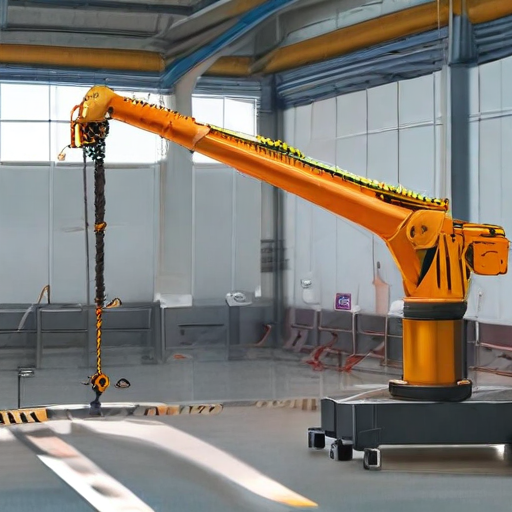
How to use “articulating jib crane”
An articulating jib crane is a versatile lifting device equipped with a pivoting arm, which allows for easy maneuverability and precise positioning of loads. Here are the essential steps to use an articulating jib crane effectively:
1. Inspection: Before operation, inspect the crane for any visible damages or wear. Ensure all bolts, pins, and safety devices are intact and properly secured.
2. Load Assessment: Determine the weight of the load. Ensure it does not exceed the crane’s rated capacity. Check the load’s balance and secure it with appropriate lifting equipment, such as slings or straps.
3. Positioning: Position the crane’s base in a stable and level location. The base must be securely mounted to prevent any movement during operation.
4. Adjustments: Adjust the jib arm to the desired height and angle. The articulating arm allows for flexible positioning around obstacles and in confined spaces.
5. Attachment: Attach the load to the hook or lifting device at the end of the crane’s arm. Double-check all connections to ensure they are secure.
6. Lifting: Gradually lift the load by operating the crane’s controls. Some articulating jib cranes use manual operation, while others may have powered controls. Lift the load slowly to maintain control and stability.
7. Maneuvering: Use the articulating arm to maneuver the load to the desired location. The arm can pivot, allowing you to move the load horizontally and vertically with precision.
8. Lowering: Carefully lower the load into place. Ensure that the load is stable and properly positioned before detaching it from the crane.
9. Securing: Once the load is in place, secure it as needed and detach the lifting equipment.
10. Inspection: Post-operation, inspect the crane for any signs of wear or damage and report any issues for maintenance.
Using an articulating jib crane involves careful planning and attention to safety protocols to ensure efficient and safe lifting operations.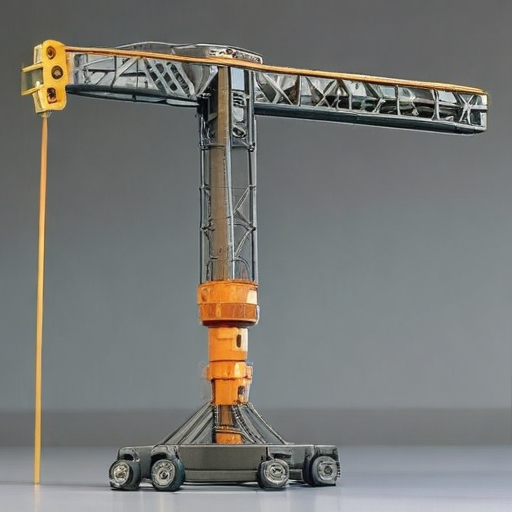
“articulating jib crane” Comparative Analysis
An articulating jib crane stands out for its versatility and dexterity, distinguishing itself from other crane types through its unique pivoting arm system, allowing for enhanced precision in confined or intricate workspaces. Here’s a comparative analysis highlighting its core attributes relative to other crane systems:
1. Design and Flexibility:
– Articulating Jib Crane: Features multiple pivot points, usually with an arm that can bend and rotate within a broader range. This design allows it to reach around obstacles and position loads with high precision, making it ideal for assembly lines, workshops, and areas with restricted space.
– Traditional Jib Crane: Typically has a single, fixed arm that can only pivot horizontally. It offers straightforward operation but limited maneuverability compared to an articulating jib crane.
– Overhead Bridge Crane: Extends across a bridge structure and moves loads along two primary axes (X and Y). While suitable for heavier loads and large open spaces, its installation and movement are less flexible.
2. Load Capacity and Reach:
– Articulating Jib Crane: Generally supports lighter to moderate loads (up to a few tons). Its segmented arms allow loads to be moved with greater precision but within a somewhat smaller radius.
– Traditional Jib Crane: Often capable of handling comparable or slightly higher loads than articulating jib cranes but within a fixed arc.
– Overhead Bridge Crane: Usually designed for significantly heavier loads due to its robust construction. It can cover large horizontal areas, but its vertical maneuverability is limited to the hoist’s travel.
3. Application and Efficiency:
– Articulating Jib Crane: Best suited for tasks requiring frequent position adjustments and high maneuverability. Common in manufacturing, maintenance, and small-scale logistics where precision is critical.
– Traditional Jib Crane: Favored in environments where straight-line loading and unloading are sufficient.
– Overhead Bridge Crane: Ideal for industries requiring consistent, high-capacity load transfer over expansive areas, such as warehouses, production lines, and shipping yards.
Conclusion: Articulating jib cranes excel in environments needing flexible, precise load handling within confined spaces, offering superior maneuverability over traditional jib and overhead bridge cranes. Their specialized design is an asset in settings where adaptability and precision are paramount.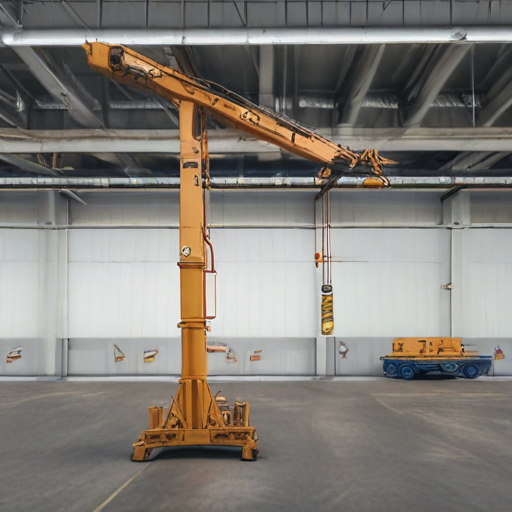
“articulating jib crane” Warranty and Support
Our articulating jib cranes come with a comprehensive warranty to ensure your peace of mind and the continued high performance of your equipment. Each crane is warranted for a period of one year from the date of purchase against defects in materials and workmanship. During this warranty period, we will repair or replace any components that are found to be defective, at no cost to you. This warranty does not cover damage caused by improper use, lack of maintenance, or unauthorized modifications.
To maintain the validity of your warranty, we recommend following our detailed maintenance guidelines provided in the user manual. Regular inspections and proper maintenance are crucial for the long-term reliability and safety of your articulating jib crane.
Our dedicated support team is here to assist you throughout the life of your product. We offer multiple channels of support to ensure you get the help you need, when you need it:
1. Customer Service Hotline: Available 24/7 for immediate assistance with any technical issues or questions.
2. Email Support: Reach out to us at [email protected] for non-urgent queries. Our team usually responds within 24 hours.
3. Online Resources: Access a wealth of information including user manuals, troubleshooting guides, and maintenance checklists on our website’s support section.
We also provide optional extended warranty plans and maintenance packages for added protection and peace of mind. Contact our sales team for more details on these options.
Your satisfaction is our highest priority. We are committed to providing you with robust warranty coverage and unparalleled support to ensure your articulating jib crane operates efficiently and effectively. Thank you for choosing our product.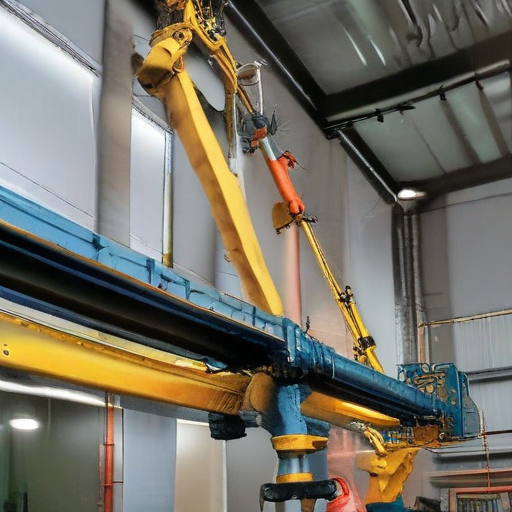
List “articulating jib crane” FAQ
Certainly! Here are some frequently asked questions (FAQs) about articulating jib cranes:
1. What is an articulating jib crane?
– An articulating jib crane features an arm with two swivel points, allowing for easier positioning and greater flexibility in lifting and moving loads.
2. Where can articulating jib cranes be used?
– They are commonly used in manufacturing, assembly lines, warehouses, and workshops where precise positioning and movement of materials are required.
3. What are the benefits of using an articulating jib crane?
– They offer increased maneuverability, flexible operation around obstacles, and can handle varied lifting tasks with greater control compared to traditional jib cranes.
4. What load capacities are available for articulating jib cranes?
– Load capacities typically range from a few hundred pounds to several tons, depending on the crane’s design and specifications.
5. Can an articulating jib crane be customized?
– Yes, many manufacturers offer custom designs to meet specific workspace requirements, including varying arm lengths, mounting options, and load capacities.
6. What are the mounting options for these cranes?
– They can be mounted on walls, columns, or floors. Wall and column-mounted models save floor space, while floor-mounted versions offer flexibility in positioning.
7. Do articulating jib cranes require any special maintenance?
– Regular maintenance checks are recommended to ensure optimal performance. This includes inspecting the swivel points, bearings, and load-bearing parts for wear and proper lubrication.
8. Are there any safety standards for operating articulating jib cranes?
– Yes, operators should adhere to OSHA regulations and guidelines provided by the manufacturer to ensure safe operation. Proper training and regular safety inspections are essential.
9. What power options are available?
– They can be operated manually, electrically, or pneumatically, offering various power options based on the specific needs of the application and the available infrastructure.
10. Can articulating jib cranes be integrated with other lifting equipment?
– Yes, they can be used in conjunction with hoists, trolleys, and other lifting devices to enhance their functionality and efficiency in material handling tasks.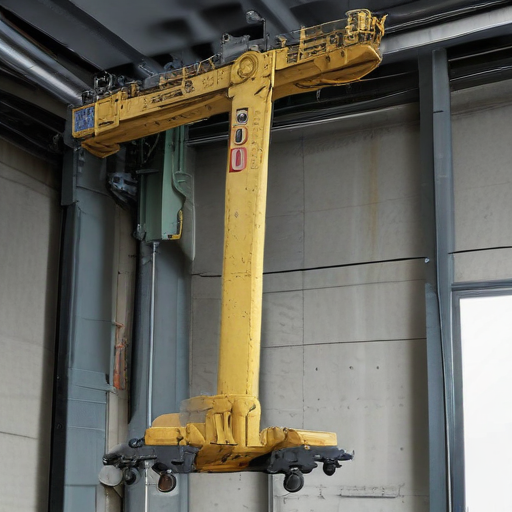
Top 10 FAQ with answer about articulating jib crane for Buyer Sourcing from China
Sure, here are the top 10 frequently asked questions (FAQ) with concise answers for buyers sourcing articulating jib cranes from China:
1. What is an articulating jib crane?
– An articulating jib crane has two rotating arms (or booms), which allow for greater flexibility in lifting and positioning loads within a 3D workspace.
2. Why should I choose an articulating jib crane?
– It’s ideal for applications requiring precise load placement, increased maneuverability, and handling of complex tasks in confined spaces.
3. What are the typical lifting capacities available?
– The lifting capacities typically range from 125 kg to 1,000 kg (approximately 275 lbs to 2,200 lbs), depending on the model and manufacturer.
4. What customization options are available?
– Customization includes varying boom lengths, height adjustments, 360-degree rotation, different mounting options (wall, floor, or ceiling), and specific material handling attachments.
5. Can I trust the quality of cranes made in China?
– Chinese manufacturers often adhere to international standards (ISO, CE, etc.). It’s important to verify certifications and customer reviews and possibly request samples before bulk purchasing.
6. What is the lead time for delivery?
– Lead times can vary but typically range from 4 to 12 weeks, depending on the complexity of the crane and order quantity.
7. What is the cost range for an articulating jib crane?
– Basic models can start around $1,000, while more advanced or customized solutions can exceed $10,000.
8. Are spare parts and after-sales services available?
– Reputable manufacturers offer spare parts and robust after-sales support, including online assistance, replacement parts, and sometimes on-site services.
9. What shipping methods are used, and how much do they cost?
– Shipping is usually done via sea freight for bulk orders due to cost efficiency, but express air options are available for urgent needs. Costs vary based on size, weight, and shipping method.
10. What about import duties and documentation?
– It’s essential to know your country’s import regulations and duties. Chinese manufacturers usually provide all necessary documents (bill of lading, packing list, commercial invoice, etc.) to facilitate the import process.
This FAQ provides a basic overview to help you make informed decisions when sourcing an articulating jib crane from China. Always consult with individual suppliers for detailed information tailored to your specific needs.

